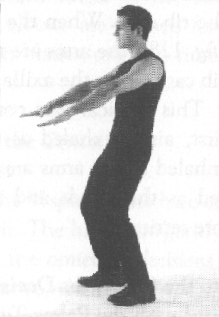
Fig. 125
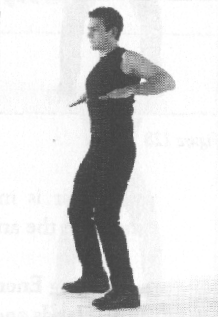
Fig. 126
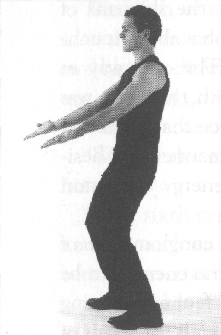
Fig. 127
The most important topic for the shamans who lived in Mexico in ancient times, and for all the shamans of don Juan's lineage, was the center for decisions. Shamans are convinced, by the practical results of their endeavors, that there is a spot on the human body which accounts for decision making, the V spot-the area on the crest of the sternum at the base of the neck, where the clavicles meet to form a letter V. It is a center where energy is rarefied to the point of being tremendously subtle, and it stores a specific type of energy which shamans are incapable of defining. They are utterly certain, however, that they can feet the presence of that energy, and its effects. It is the belief of shamans that this special energy is always pushed out of that center very early in the lives of human beings, and it never returns to it, thus depriving human beings of something perhaps more important than all the energy of the other centers combined: the capacity to make decisions.
In relation to the issue of making decisions, don Juan expressed the hard opinion of the sorcerers of his lineage. Their observations, over the centuries, had led them to conclude that human beings are incapable of making decisions, and that for this reason, they have created the social order: gigantic institutions that assume responsibility for decision making. They let those gigantic institutions decide for them, and they merely fulfil the decisions already made on their behalf.
The V spot at the base of the neck was, for those shamans, a place of such importance that they rarely touched it with their hands; if it was touched, the touch was ritualistic and always performed by someone else with the aid of an object. They used highly polished pieces of hardwood or polished bones of animals, utilizing the round head of the bone so as to have an object of the perfect contour, the size of the hollow spot on the neck. They would press with those bones or pieces of wood to create pressure on the borders of that hollow spot. Those objects were also used, although rarely, for self-massage, or for what we understand nowadays as acupressure.
"How did they come to find out that that hollow spot is the center for decisions?" I asked don Juan once.
"Every center of energy in the body," he replied, "Shows a concentration of energy; a sort of vortex of energy, like a funnel that actually seems to rotate counterclockwise from the perspective of the seer who gazes into it. The strength of a particular center depends on the force of that movement. If it barely moves, the center is exhausted, depleted of energy.
"When the sorcerers of ancient times," don Juan continued, "were scanning the body with their seeing eye, they noticed the presence of those vortexes. They became very curious about them, and made a map of them."
"Are there many such centers in the body, don Juan?" I asked.
"There are hundreds of them," he replied, "if not thousands! One can say that a human being is nothing else but a conglomerate of thousands of twirling vortexes, some of them so very small that they are, let's say, like pinholes, but very important pinholes. Most of the vortexes are vortexes of energy. Energy flows freely through them, or is stuck in them. There are, however, six which are so enormous that they deserve special treatment. They are centers of life and vitality. Energy there is never stuck, but sometimes the supply of energy is so scarce that the center barely rotates."
Don Juan explained that those enormous centers of vitality were located on six areas of the body. He enumerated them in terms of the importance that shamans accorded them. The first was on the area of the liver and gallbladder; the second on the area of the pancreas and spleen; the third on the area of the kidneys and adrenals; and the fourth on the hollow spot at the base of the neck on the frontal part of the body. The fifth was around the womb, and the sixth was on the top of the head.
The fifth center, pertinent only to women, had, according to what don Juan said, a special kind of energy that gave sorcerers the impression of liquidness. It was a feature that only some women had. It seemed to serve as a natural filter that screened out superfluous influences.
The sixth center, located on top of the head, don Juan described as something more than an anomaly, and refrained absolutely from having anything to do with it. He portrayed it as possessing not a circular vortex of energy, like the others, but a pendulumlike, back-and-forth movement somehow reminiscent of the beating of a heart.
"Why is the energy of that center so different, don Juan?" I asked him.
"That sixth center of energy," he said, "doesn't quite belong to man. You see, we human beings are under siege, so to speak. That center has been taken over by an invader, an unseen predator. And the only way to overcome this predator is by fortifying all the other centers."
"Isn't it a bit paranoiac to feel that we are under siege, don Juan?" I asked.
"Well maybe for you, but certainly not for me," he replied. "I see energy, and I see that the energy over the center on the top of the head doesn't fluctuate like the energy of the other centers. It has a back-and-forth movement, quite disgusting, and quite foreign. I also see that in a sorcerer who has been capable of vanquishing the mind, which sorcerers call a foreign installation, the fluctuation of that center has become exactly like the fluctuation of all the others."
Don Juan, throughout the years of my apprenticeship, systematically refused to talk about that sixth center. On this occasion when he was telling me about the centers of vitality, he dismissed my frantic probes, rather rudely, and began to talk about the fourth center, the center for decisions.
"This fourth center," he said, "has a special type of energy, which appears to the eye of the seer as possessing a unique transparency, something that could be described as resembling water: energy so fluid that it seems liquid. The liquid appearance of this special energy is the mark of a filterlike quality of the center for decisions itself, which screens any energy coming to it, and draws from it only the aspect of it that is liquidlike. Such a quality of liquidness is a uniform and consistent feature of this center. Sorcerers also call it the watery center.
"The rotation of the energy at the center for decisions is the weakest of them all," he went on. "That's why man can rarely decide anything. Sorcerers see that after they practice certain magical passes, that center becomes active, and they can certainly make decisions to their hearts' content, while they couldn't even take a first step before."
Don Juan was quite emphatic about the fact that the shamans of ancient Mexico had an aversion that bordered on phobia about touching their own hollow spot at the base of the neck. The only way in which they accepted any interference whatsoever with that spot was through the use of their magical passes, which reinforce that center by bringing dispersed energy to it, clearing away, in this manner, any hesitation in decision making born out of the natural energy dispersion brought about by the wear and tear of everyday life.
"A human being," don Juan said, "perceived as a conglomerate of energy fields, is a concrete and scaled unit into which no energy can be injected, and from which no energy can escape. The feeling of losing energy, which all of us experience at one time or another, is the result of energy being chased away, dispersed from the five enormous natural centers of life and vitality. Any sense of gaining energy is due to the redeployment of energy previously dispersed from those centers. That is to say, the energy is relocated onto those five centers of life and vitality."
THE MAGICAL PASSES FOR THE CENTER FOR DECISIONS
1. Bringing Energy to the Center for Decisions with a Back-and-Forth Motion of the Hands and Arms with the Palms Turned Downward
The arms shoot out to the front at a forty-five-degree angle with an exhalation, the palms of the hands facing down (fig. 125). Then they are retrieved to the sides of the chest, under the axilla, with an inhalation. The shoulders are raised in order to maintain the same degree of inclination (fig. 126). In the second facet of this movement, the arms are extended downward with an inhalation, and pulled back with an exhalation.
2. Bringing Energy to the Center for Decisions with a Back-and-Forth Motion of the Hands and Arms with the Palms Turned Upward
This magical pass is like the preceding one, and it is executed in exactly
the same fashion, except that it is done with the palms of the hands turned
upward (fig. 127). The inhalations and exhalations are also exactly as
in the preceding movement. Air is exhaled as the hands and arms move forward
at a forty-five-degree level of inclination, and it is inhaled as the arms
move backward. Then air is inhaled as the hands and arms move downward,
and exhaled as the hands and arms retrieve.

Fig. 125 |

Fig. 126 |

Fig. 127 |
3. Bringing Energy to the Center for Decisions with a Circular Motion of the Hands and Arms with the Palms Turned Downward
This magical pass begins exactly like the first one of this group, except that when the hands reach their fully extended position, two complete circles are drawn with the hands and the arms going away from each other to reach a point about six inches beyond the rib cage. When the hands complete the circles (fig. 128), the arms are retrieved to the sides of the rib cage under the axilla.
This magical pass consists of two facets. In the first, air is exhaled as the circles are drawn and inhaled as the arms are retrieved backward. In the second, air is inhaled as the hands and arms draw the circles and exhaled as the arms are retrieved.
4. Bringing Energy to the Center for Decisions in a Circular Motion of the Hands and Arms with the Palms Turned Upward
This magical pass is exactly like the preceding one, with the same two facets of inhalation and exhalation, but the two circles are drawn by the hands and arms with the palms of the hands turned upward (fig. 129).
5. Bringing Energy to the Center for Decisions from the Midsection of the Body
The arms are bent at the elbows and kept high, at the level of the shoulders.
The fingers are kept loosely pointing toward the V spot, but without touching
it (fig. 130). The arms move in a teetertotter fashion from right to left
and left to right. The motion is not accomplished by moving the shoulders
or the hips, but by the contraction of the muscles of the stomach, which
moves the midsection to the right, to the left, and to the right again,
and so on.
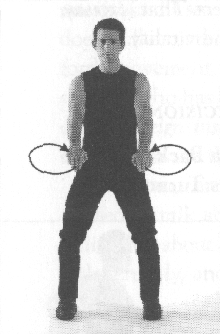
Fig. 128 |
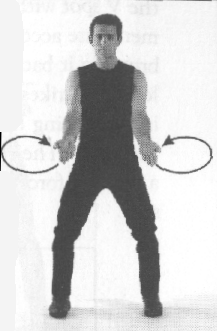
Fig. 129 |
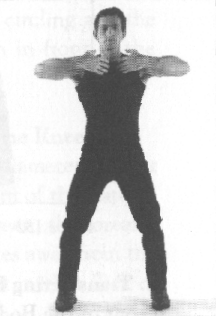
Fig. 130 |
6. Bringing Energy to the Center for Decisions from the Area of the Shoulder Blades
The arms are bent, as in the previous movement, but the shoulders are rounded so that the elbows are heavily drawn toward the front. The left hand is placed on top of the right. The fingers are held loose, pointing toward the V spot without touching it, and the chin juts out and rests on the hollow spot between the thumb and index finger of the left hand (fig. 131). The bent elbows are pushed for, ward, extending the shoulder blades, one at a time, to the maximum.
7. Stirring Energy Around the Center for Decisions with a Bent Wrist
Both hands are brought to the V spot on the base of the neck, without
touching it. The hands are gently curved; the fingers point at the center
for decisions. Then the hands begin to move, the left first, for, towed
by the right, as if stirring a liquid substance around that area, or as
if they were fanning air into the V spot with a series of gentle movements
of each hand; these movements are accomplished by extending the whole arm
laterally and then bringing it back to the area in front of the V spot
(fig. 132). Then the left arm strikes out in front of the V spot, with
the hand turned sharply inward, using the wrist and the back of the hand
as a striking surface (fig. 133). The right arm executes the same movement.
In this manner, a series of forceful blows are delivered to the area right
in front of the V spot.
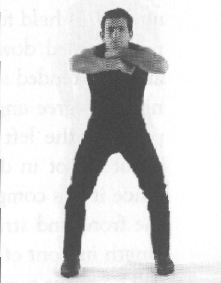
Fig. 131 |
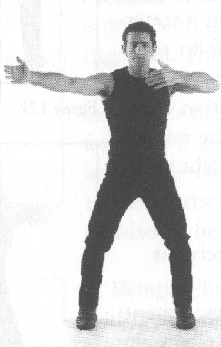
Fig. 132 |
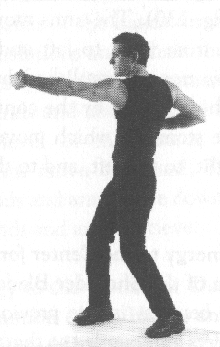
Fig. 133 |
8. Transferring Energy from the Two Centers of Vitality on the Front of the Body to the Center for Decisions
Both hands are brought to the area of the pancreas and spleen, a few inches in front of the body. The left hand, with the palm turned upward, is held four or five inches below the right one, which has the palm turned downward. The left forearm is held at a ninety-degree angle, extended straight out to the front. The right forearm is also at a ninety-degree angle, but held close to the body, so that the fingertips point to the left (fig. 134). The left hand makes two inward circles about a foot in diameter around the area of the pancreas and spleen. Once it has completed the second circle, the right hand shoots out to the front and strikes with the edge of the hand, to the area an arm's length in front of the liver and gallbladder (fig. 135).
The exact same movements are performed on the other side of the body
by reversing the position of the hands, which are brought to the area of
the liver and gallbladder, with the right hand circling and the left hand
striking forward to the area an arm's length in front of the pancreas and
spleen.
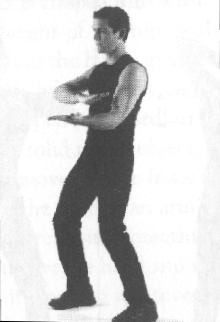
Fig. 134 |
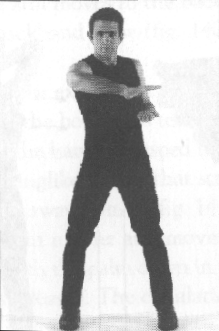
Fig. 135 |
9. Bringing Energy to the Center for Decisions from the Knees
The left hand and arm draw two circles about a foot in diameter in front of the V spot, a bit toward the left (fig. 136). The palm of the hand is facing downward. Once the second circle has been drawn, the forearm is raised to the level of the shoulder and the hand strikes away from the face, diagonally to the right, at the level of the V spot, with a flick of the wrist, as if holding a whip (fig. 137 ). same movements are performed with the right hand.
Then a deep inhalation is taken and an exhalation follows as the hands and arms slide downward until they reach the tops of the knees, with the palms facing up. A deep inhalation is taken there and the arms are raised, with the left arm in the lead., the right arm crosses over the left as they go over the head until the fingers rest on the back of the neck. The breath is held as the top of the trunk moves three times in succession in a teeter-totter motion; the left shoulder goes down first, then the right, and so on (fig. 138). Then the air is exhaled as the arms and hands move back downward to the tops of the knees, again with the palms of the hands facing up.
A deep inhalation is taken, and then the air is exhaled as the hands are raised from the knees to the level of the V spot, with the fingers pointing toward it, without touching it (fig. 139). The hands are brought once more to the knees with an exhalation. A final deep inhalation is taken and the hands are raised to the level of the eyes, and then brought down to the sides as the air is exhaled.
The next three magical passes, according to don Juan, transfer energy
which belongs only to the center for decisions from the frontal
edge of the luminous sphere, where it has accumulated over the years, to
the back, and then from the back of the luminous sphere to the front. He
said that this energy transferred back and forth goes through the V spot,
which acts as a filter, utilizing only the energy that is proper to it
and discarding the rest. He pointed out that because of this selective
process of the V spot, it is essential to perform these three magical passes
as many times as possible.
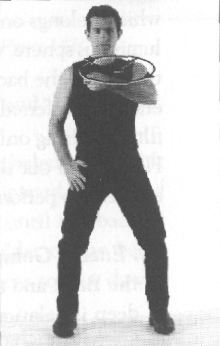
Fig. 136 |
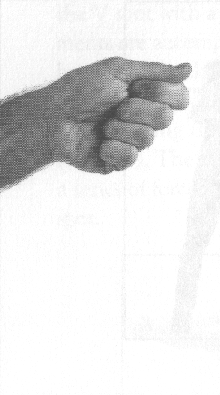
Fig. 137 |
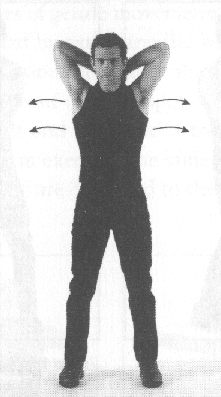
Fig. 138 |
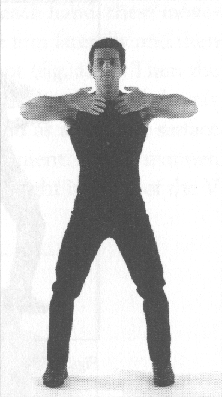
Fig. 139 |
10. Energy Going Through the Center for Decisions from the Front to the Back and the Back to the Front with Two Blows
A deep inhalation is taken. Then the air is slowly exhaled as the left arm strikes out at the level of the solar plexus, with the palm of the hand turned upward; the palm is held flat and the fingers are together.
Then the hand is clasped into a fist. The arm moves to the back, striking from the height of the hips with a backhand blow (fig. 140). The exhalation ends as the hand opens.
Another deep inhalation is taken. A slow exhalation follows while the palm of the open hand, still in back of the body, taps ten times as if lightly hitting a solid round object. Then the hand is clasped into a fist before the arm moves to the front in a swinglike punch that strikes an area in front of the V spot, an arm's length away from it (fig. 141). The hand opens as if releasing something held in it. The arm moves down, back, and then over the head and strikes with the palm down in front of the V spot, as if breaking whatever it has released. The exhalation ends then (fig. 142).
The same sequence of movements is repeated with the right arm.
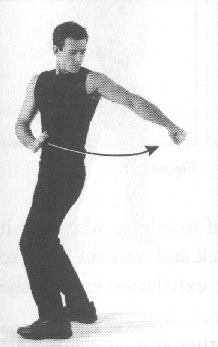
Fig. 140 |
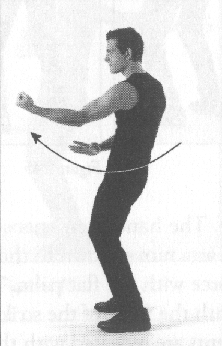
Fig. 141 |
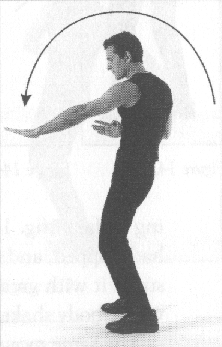
Fig. 142 |
11. Transferring Energy from the Front to the Back and the Back to the Front with the Hook of the Arm
A deep inhalation is made. Then the air is slowly exhaled as the left arm moves forward with the palm of the hand turned upward. The hand is quickly clasped into a fist. The fisted hand rotates until the back of the hand is turned upward and strikes over the shoulder to the back, The fisted palm faces upward. The hand opens and turns to face downward, and the exhalation ends.
Another deep inhalation is taken. Then a slow exhalation begins as the hand, made into a downward hook, scoops three times, as if rolling a solid substance into a ball (fig. 143). The ball is tossed upward to the level of the head with a flick of the hand and forearm (fig. 144), and quickly grabbed with the hand bent again at the wrist like a hook (fig. 145). The arm moves to the front, then to the height of the right shoulder and strikes forward to an area right in front of the V spot an arm's length away from it, using the wrist and the back of the hand as a striking surface (fig. 146). The hand then opens as if to release whatever it had trapped, and the arm moves down to the back and over the head to strike it with great force with the flat palm. The exhalation ends as the whole body shakes with the force of the strike.
The same movements are repeated with the other arm.
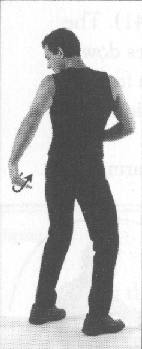
Fig. 143 |
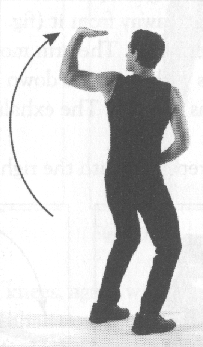
Fig. 144 |
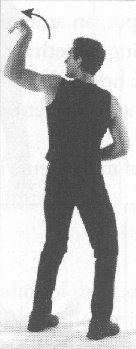
Fig. 145 |
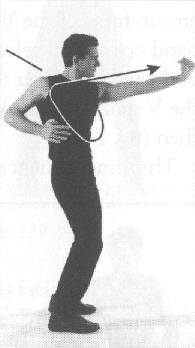
Fig. 146 |
12. Transferring Energy from the Front to the Back and the Back to the Front with Three Blows
A deep inhalation is taken. A slow exhalation follows as the left arm
strikes forward with the hand open, the flat palm turned upward. The hand
is quickly clasped into a fist, and the arm retrieves as if to deliver
an elbow blow to the back. Then it moves laterally to the right and delivers
a side punch with the forearm rubbing on the body (fig. 147). The elbow
is retrieved again as if to deliver an elbow blow to the back. The arm
is extended and moved out to the left side and to the back, to deliver
the fourth blow behind the body with the back of the fisted hand. The exhalation
ends as the hand opens (fig. 148).
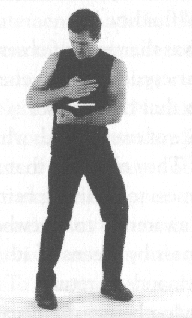
Fig. 147 |
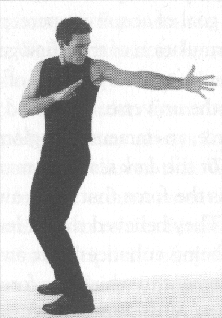
Fig. 148 |
A deep inhalation is taken again. A slow exhalation follows as the hand, bent downward into a hook, scoops three times. Then the hand grabs as if it were clasping something solid (fig. 149). The arm swings to the front at the level of the center for decisions. It continues to the right shoulder; there the forearm makes a loop upward and delivers a back-fist blow to the area in front of the V spot, an arm's length away from it (fig. 150). The hand opens as if to release something that it was clasping. Then it moves down, goes behind the body, comes above the head, with the palm of the hand down, and smashes whatever it released with a forceful blow of the open hand. The slow exhalation ends there (fig. 151).
The same movements are repeated with the right arm.
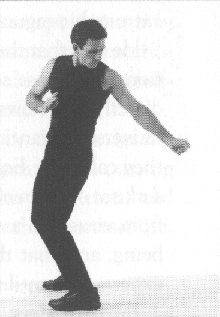
Fig. 149 |
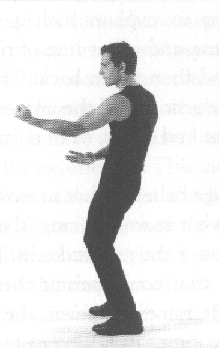
Fig. 150 |
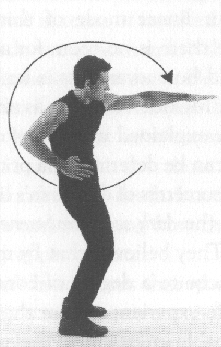
Fig. 151 |